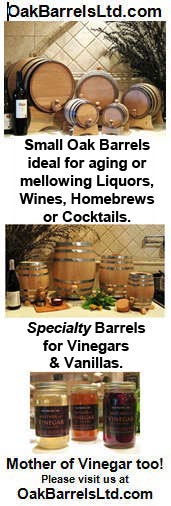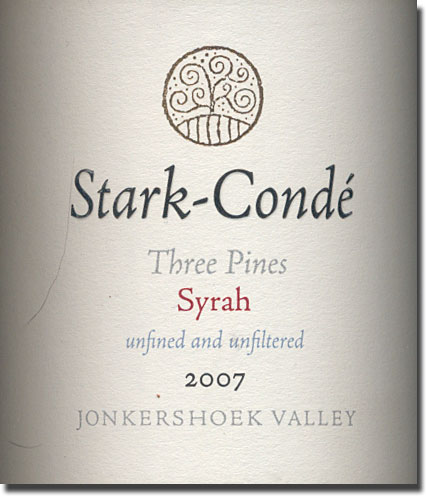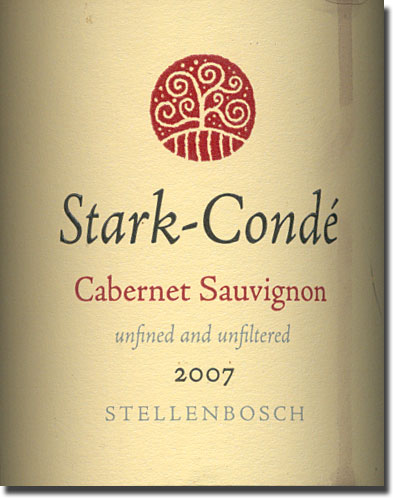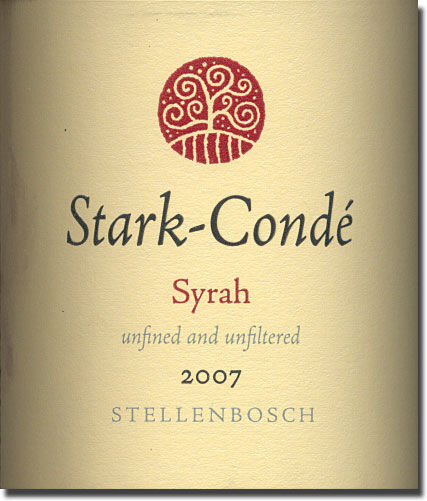Three from Stark-Condé
As far as I can tell, Stark-Condé isn’t any more a household name here in the US now than when I last reviewed six of their wines a little over four years ago. They were distributed here in the Detroit area back then; I actually sold them in a wine department I managed at that time, but I don’t see much of them in my travels these days. Stark-Condé Wines is a family-run winery, operated by graphic designer-become winemaker José Condé, with total production of less than 3000 cases yearly. Their intent is “to make carefully crafted wines that speak with personality of a particular place” (all grapes are sourced from their “Oude Nektar” farm vineyards in Jonkershoek Valley in Stellenbosch), but for my tastes, they could come from a variety of regions around the world, so “internationally” styled are they.
I was pleased to see these three in a box of review samples that we recently received from our friends at Vineyard Brands, because I enjoyed those that we’d surveyed previously. Now, as then, they seem to show more in the way of “house style” than any “sense of place,” and that’s not necessarily a bad thing.
2007 Stark-Condé Cabernet Sauvignon Stellenbosch, 86% Cabernet Sauvignon, 7% Merlot, 5% Petit Verdot, 2% Cabernet Franc, 14.5% alc., $27.00 SRP: Deeply, darkly colored, with soft leather and cocoa on the nose; these impressions echo and expand on the palate, with a solid core of black currant and berry fruit at its heart and the cocoa coming to the fore and setting the tone to the wine’s character. Full bodied, creamy smooth and deceptively well-structured for at least five years in the cellar, a good thing with regard to integrating the oak-generated chocolate. (How DO these things age, anyway?! We’ve only tried them in their youth.) With air, some nice herbal-underbrush Cabernet Franc-like undertones emerge to add interest to this Cocoa Puff, so I think there might be hope for it. Give it an hour in a decanter now, or better, some years in the cellar. Vineyard Brands tech sheet reports: “A range of yeast was used, several domestic and an imported Bordeaux yeast. About 20% also underwent fermentation with the natural yeasts. Only 300 (liter) French oak was used, of which about 40% were new. After 18 months barrel maturation the blend was assembled and put back to barrels for a further 4 months integration. After 22 months barrel maturation, the wine was bottled without fining or filtration.” Find this wine
2007 Stark-Condé Syrah Stellenbosch, 14.5% alc., $27.00 SRP: Deep, inky color; pretty sweet oak, plum and blueberry flavors and aromas are underscored with a note of earth. As it opens with air, some coffee, toast and a hint of bacon emerges, but the sweet oak and ripe fruit rule here. The ample structure and a smooth, creamy texture tend to offset each other; this is a big wine, obviously in a New World style, and if that’s not your thing, you won’t like it. I can appreciate it for what it is, and would be quite interested in trying one with five years or more in the cellar to see how it develops. “…inoculated with a mix of domestic and imported Rhône yeasts. About 30% of the wine underwent natural fermentation and about 5% was whole-bunch fermented. A mix of coopers was used, all French oak, all 300 litre, mostly second-fill (about 30% new). After 22 months barrel maturation, the wine was bottled without fining or filtration.” Find this wine
2007 Stark-Condé Syrah Stellenbosch Three Pines, 14.5% alc., $35.00: Clean, dark color, with a pretty, unabashedly New World nose of creamy oak over red and black plum, cherry and berry; flavors echo on a full bodied frame with substantial structure and an earthy base. The creamy oak doesn’t quite dominate the fruit, and again, this is one for those with “international palates.” No real varietal character apparent at this point (reminiscent of many of Ridge’s Lytton Syrahs in that regard), just a pretty good red wine for what it is. “About 50% of the blend was natural fermentation and the balance was split between a domestic yeast and an imported Rhône yeast. A mix of coopers was used, all French oak, all 300 litre, mostly second-fill (about 30% new). The wine was bottled unfined and unfiltered after 22 months barrel maturation.” Find this wine
My final take on these three is that they are all quite nice, and will be appreciated by anyone who likes wines from Napa and Sonoma County. They’re well-made, they deliver the goods, and that’s not a bad bottom line in my book.
Reporting from Day-twah,
geo t.






